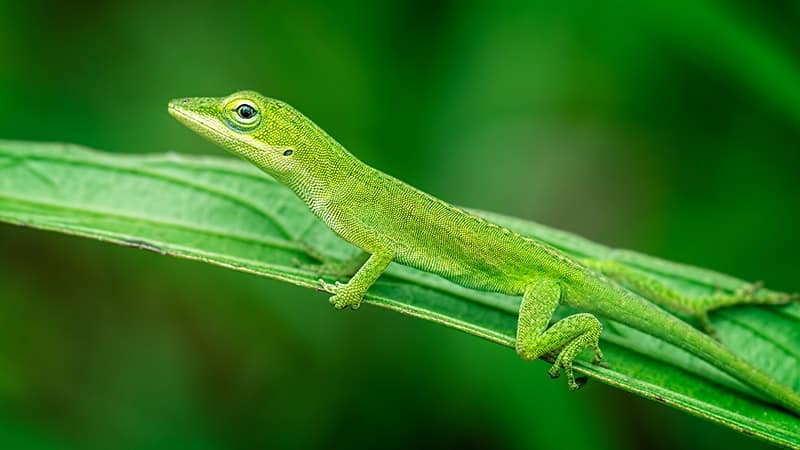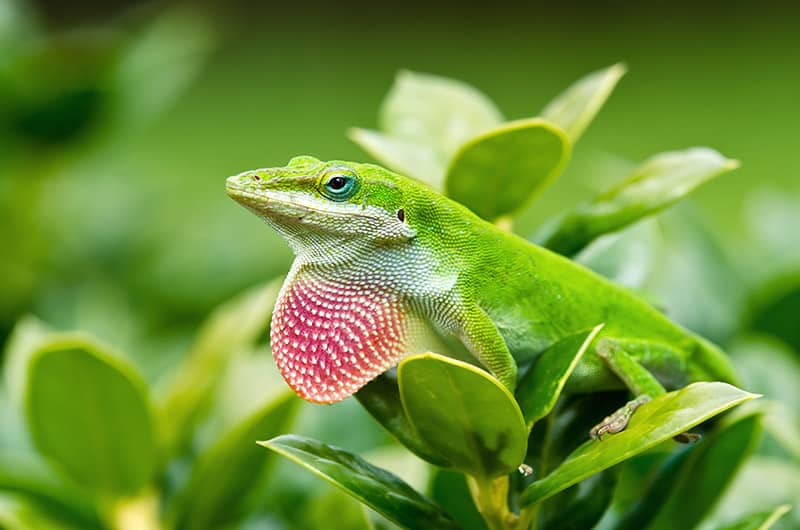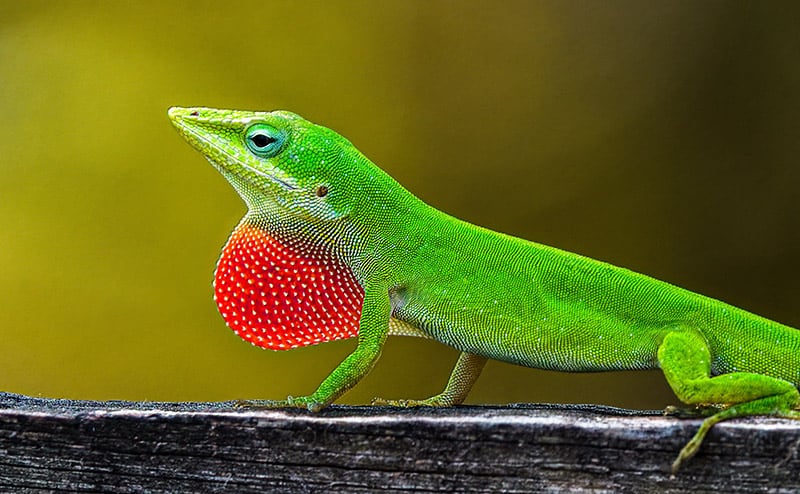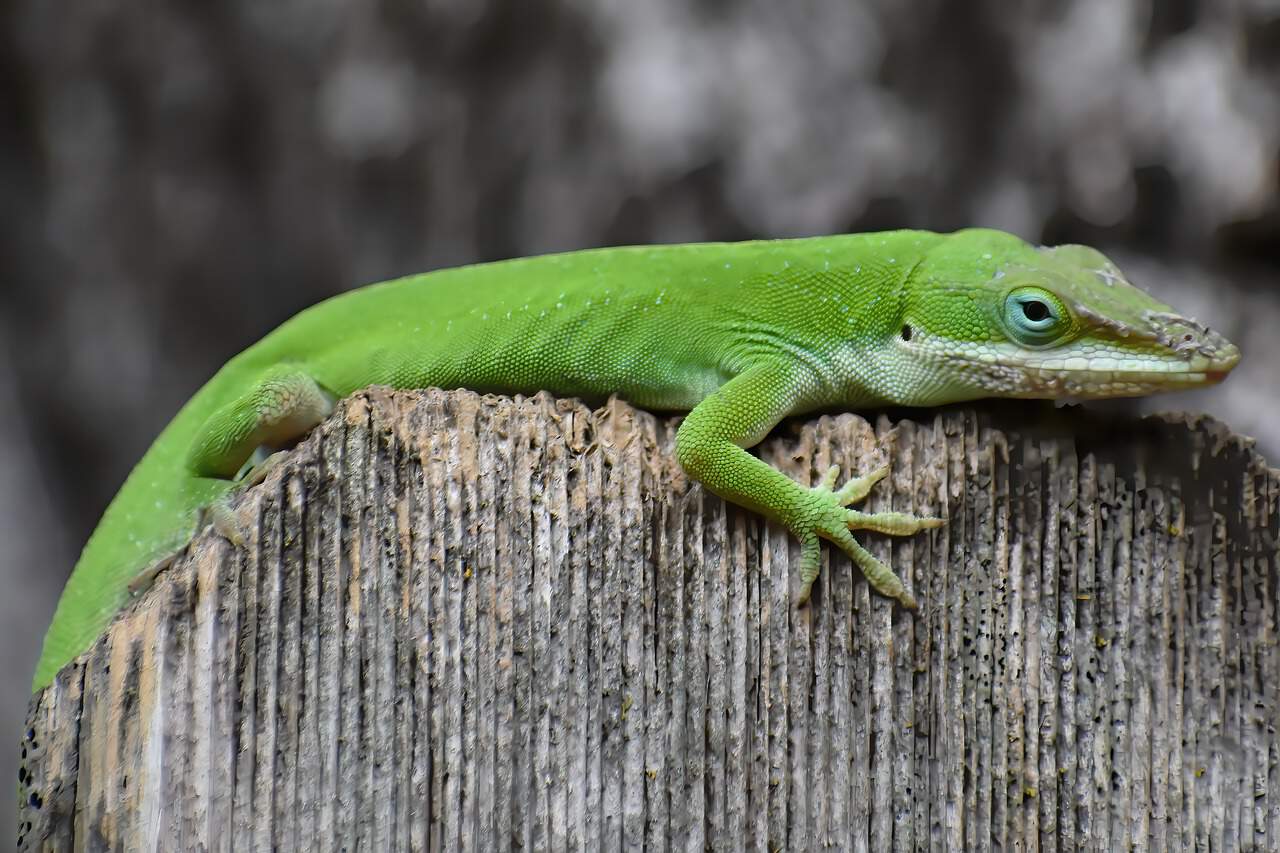The Green Anole, dubbed the American Chameleon, has an amazing ability to change colors!
The Green Anole Anolis carolinensis can change color to various shades of green and brown. They tend to turn dark brown when stressed or ill. When content, warm, and healthy, they tend to be green. Yet this is an not always the case, their color can also be affected by environmental conditions and even food items. Because of their color changing abilities they are sometimes called the “American Chameleon”, but they are not related to true Chameleons.
These little lizards are quite common and have long been a popular pet. They are both attractive and intriguing to many enthusiasts. Many of the males have a strawberry-red dewlap, but some populations from southwest Florida, designated the Southern Green Anole Anolis c. seminolus have a gray or greenish dewlap. They are relatively hardy, inexpensive, and easy to care for. Their small size makes them suitable for a small aquarium and they can easily fit into a wide variety of lifestyles and home environments.
Green Anoles are active lizards that are not aggressive, preferring to scamper away rather than bite. Although they are small and inexpensive, they are a more specialized lizard in care and behavior, so are not necessarily the best lizard for all beginners. These lizards are best kept as visual pets rather than handled. They are rather delicate and difficult to hold on to. They can easily be injured and If they are grabbed by the tail it will break. Being very quick, this small lizard can also easily get lost. Anoles that do get regular gentle handling however, can become content to hang on your finger or cling to your shirt, without jumping and running for safety.
- For more information on keeping pet lizards see: Reptile Care: Keeping Reptiles and Amphibians as Pets
Scientific Classification
| Kingdom: | Animalia |
| Phylum: | Chordata |
| Class: | Reptilia |
| Order: | Squamata |
| Family: | Iguanidae |
| Genus: | Anolis |
| Species: | carolinensis carolinensis |
Scientific Name

Habitat: Distribution/Background
The Green Anole Anolis carolinensis was described by Voight in 1832. Besides the United States, the Green Anole is native to the Bahamas, Cuba, and Mexico. There are other variations of anoles in the United States, including the Brown Anole, but the Green Anole is the only anole species regarded as native here. It is thought the Green Anole was introduced into the United States, but it was a very, very long time ago. They have also been introduced to Hawaii, Belize, Anguilla, Cayman Islands, Guam; Northern Mariana Islands, Palau, Spain, and parts of Japan.
The Green Anole inhabits a large range including almost every Gulf Coast state, up through Virginia, and as far inward as Tennessee and Oklahoma. The Northern Green Anole Anolis c. carolinensis is found throughout the entire range, while the Southern Green Anole Anolis c. seminolus is occurs only in southern Florida. Other common names it is known by are American Chameleon, Carolina Anole, Red-throated Anole, and Tree Lion
Status
The Anolis carolinensis is on the IUCN Red List for Endangered Species as Least Concern (LC). The Green Anole has a wide distribution with a large population and a number of subpopulations that are thought to be relatively stable.
Description
The Green Anoles, true to their name, are bright green lizards. They have a wonderful color-changing ability and can go from bright green to dark green to brown. They reach about 6″ to 7″ (15 – 18 cm) when fully grown. The males have a flap of skin under their throats called a ‘dewlap‘. This dewlap when flared out for mating display is generally pink, though in the Southern Green Anole it is gray, greenish, or might be white. Males are larger and the base of their tails is often thicker than that of the female. Their average lifespan is 3 to 5 years, though they can live as long as 7 to 10 years.
Food and Feeding
Green Anoles are insectivores and have no need of any sort of vegetable. They eat crickets, some mealworms, and even an occasional wax worm. Crickets should be gut loaded or dusted in a calcium and vitamin powder prior to feeding. Anoles are diurnal (active during the day), so their crickets should be fed during the day rather than at night. A water bowl should be provided and filled with decholrinated water daily.

Housing
A single Green Anole can easily be housed in a ten gallon aquarium. For 2 to 6 anoles, provide at least a twenty gallon ‘tall’ aquarium, though if you have mostly males you will want to go larger. The substrate can be either carpet or a substrate such as crushed walnut shells (Nature Zone Litter).
As anoles are arboreal (tree-dwelling), vertically mounted pieces of driftwood or grapevine are welcome to climb on. Artificial vines attached to the side of the cage with suction cups are also welcome additions.
Temperature, humidity, and Lighting requirements:
Lighting for Green Anoles, though not as extensive as for some lizard species, is still important. They are diurnal and need UVB exposure for proper metabolism and to synthesize Vitamin D3. The best bulbs for this are ones that emit both UVB and UVA, such as Repti-Sun 5.0 (ZooMed) or Repti-Glo 5.0 (Hagen). Mist the anoles daily.
Green Anoles, like all lizards, need to thermoregulate their bodies. You can provide the necessary environment with a simple warm ‘basking’ type area in one spot of the terrarium and a cooler area in another spot. A 50 watt daytime bulb mounted above the basking area will provide any heat these lizards might need. The basking area should be between 85 – 90{deg} F (29 – 32{deg} C) and the cooler area should be about 70 – 75{deg} F (21 – 24 {deg} C). This can be accomplished on a wide terrarium by mounting bulbs on one end and letting the other end be cooler. For tall terrariums the bulbs are mounted at the top and the cooler area is below.
Cage Care
Cage maintenance is an important part of keeping reptiles healthy, and long-lived. Reptiles being kept in a confined area as pets need to be protected from harmful micro-organisms and parasites. The reptile cage needs daily and weekly maintenance. Check on a daily basis to make sure that the tank is clean. Regularly clean the carpet with an approved reptile cleaner or scoop out the waste from the Nature Zone litter.
Everything you put into their home should be washed and disinfected weekly. This includes dishes and cage decor. The litter will need to be changed only once every six months. Never clean with a phenol such as Pine Sol. Chlorine and alcohol based cleaners are tolerated much better, but need to be thoroughly rinsed.

Behavior
Green Anoles do very well when kept singly. Other than when they mate, they typically do not like the company of other anoles. If you are keeping several together you will want to be sure you have at least one or more females for every male. Though generally not aggressive, male anoles are often territorial with other males. When in this mood, they can also be bossy towards females and are more likely to bite.
They are typically shy and will quickly run away when they perceive a threat. With a bit of handling they become more social with humans, but are still prone to jumping.
Handling
Green Anoles are nervous and jumpy, and being handled is stressful to them. They will be most content if kept as visual pets, but you will have to move them occasionally for cage maintenance.
They are typically shy and will quickly run away when they perceive a threat. With a bit of handling they become more social with humans, but are still prone to jumping. Anoles that do get regular handling can become content to hang on your finger or cling to your shirt, without jumping and running for safety.
Approach them in a gentle calm manner, don’t make any sudden moves. Rather than approaching them from above, place your hands on each side and cup them, supporting the belly. You can then lightly hold the anole’s head between your thumb and first finger just enough to keep the jaw from opening. NEVER grab an anole by the tail, as it will separate. Be sure to always wash your hands before and after touching your anole(s).
Reproduction
Green Anoles typically breed in the spring and early summer. Females can store the sperm from the males for as long as eight months. She will lay one egg every fortnight in a moist area, so if you are hoping for some breeding, it would be wise to keep a dish with moist peat moss in the cage. She will scarcely care to cover the egg. The eggs incubate on average for about 2 months. Hatchlings are rather large, often at around 2 inches.
Diseases: Ailments/Treatments
Many ailments and illness can be avoided with proper care and a good, clean environment. The two most commonly found problems in anoles are fighting, due to too many males in one cage, and vitamin deficiencies. Vitamin deficiencies can be reduced with a good herp vitamin, such as Herpetivite.

Availability
Green Anoles are very common and are readily available.
Featured Image Credit: Ray_Shrewsberry, Pixabay
